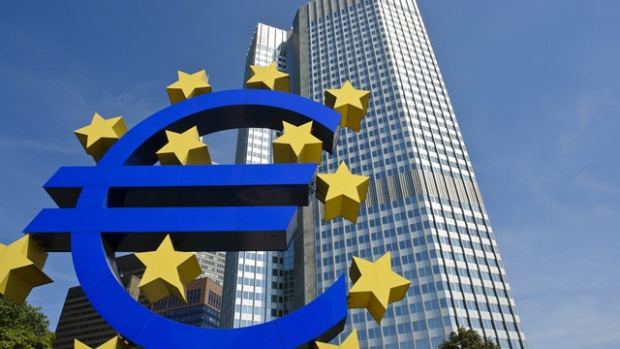Jul 21, 2016
European Central Bank holds interest rates at record lows
Reuters

The European Central Bank kept its interest rates and forward guidance unchanged as expected on Thursday but will likely use a news conference to address a growing list of obstacles that again threaten to derail its efforts to lift growth and inflation.
Italy’s bank troubles, Britain’s decision to leave the European Union and difficulty in finding enough bonds to buy in its asset purchase programme may all require some action, dashing ECB chief Mario Draghi’s hopes that the bank was done after years of extraordinary stimulus measures.
Not keen on hasty moves, Draghi is likely to manoeuvre through on Thursday with verbal action, highlighting the increased risks and opening the door to changes as soon as September, when the bank releases fresh economic forecasts.
The trick will be to sound dovish enough to signal readiness to act but without committing or overly inflating market expectations that could ultimately lead to disappointment, even if the bank provides more stimulus.
The ECB kept its deposit rate at minus 0.4 per cent and the main refinancing rate at 0.00 per cent, both record lows, as it seeks to cut borrowing costs for firms and force banks to lend money out rather than park cash with it.
It also left unchanged its guidance that rates would stay at present or lower levels for an extended period, and well beyond its asset purchase horizon.
Regarding those purchases, the bank repeated that its 80 billion euro per month programme would run until March 2017 or beyond if necessary, until it sees an upward adjustment of inflation toward its target.
Markets’ attention now turns to Draghi’s 1230 GMT news conference where he will detail the economic outlook.
“Draghi will likely nurse market concerns about the ECB’s monetary policy by using a dovish tone and possibly pointing to further action later this year,” Florian Hense, an economist at Berenberg, said. “For the ECB it is important to keep its options open.”
The ECB is buying €1.74-trillion ($1.91-trillion) worth of assets to cut borrowing costs, induce spending, lift growth and ultimately raise inflation, which has been stuck either side of zero for the past two years.
Brexit may be the biggest single problem, threatening to thwart a modest investment and consumption-led recovery. But the ECB simply does not have enough information to work with.
Early post-Brexit data, such as Germany’s ZEW sentiment indicator and euro zone consumer confidence figures, suggest a significant drop in confidence. But such surveys are prone to sharp swings and the ECB would need a larger body of evidence before acting.
Indeed, while analysts polled by Reuters cut their 2017 euro zone growth forecasts to 1.3 per cent from 1.6 per cent, they left their inflation projection unchanged at 1.3 per cent, a mixed reading for the ECB, which targets inflation at just below 2 per cent.
Draghi is expected to argue that Brexit is a political problem, requiring governments, not the central bank to act, a call that is likely to fall on deaf ears, much like his repeated pleas for structural reforms that could lift potential growth.
“The ECB’s room for manoeuvre on policy is constrained by the political nature of the Brexit shock and the side-effects of further easing,” Deutsche Bank said in a note. “In that case, the sooner the ECB acts the better.”
CONSTRAINTS
With interest rates deep in negative territory and asset buys running at €80-billion per month, the ECB is indeed running short on tools, raising the threshold for any further move if the bank is to preserve some firepower for any future shock.
But some policy changes are still likely in the coming months because the ECB is running out of qualified assets to buy, particularly Germany government debt, as yields fall below its deposit rate, a self-imposed limit for its buys.
Though German yields have risen sharply over the past week, still around 55 per cent of bonds trade below the deposit rate, making them ineligible for ECB purchases.
The dilemma will be whether to tweak the scheme, making just technical changes, or enact a broader but more controversial shift that could fundamentally alter the nature of the ECB’s quantitative easing.
“Technical problems can be solved but they underline the limits of what can be achieved by using solely monetary policy, something Draghi is very much aware of and one of the reasons why he constantly calls for a more growth-friendly fiscal policy,” financial services group Nordea said.
Analysts polled by Reuters see mostly technical changes for now, including purchases of bonds yielding less than the deposit rate and buying a bigger portion of bonds without collective action clauses.
More fundamental changes may still come later, especially as the vast majority of analysts expect the asset buys to be extended beyond their current scheduled end next March and technical tweaks may not be enough to accommodate a major extension.
Italian banks, weighed down by about a 360 billion euro ($400-billion) bad debt and falling share prices, are also likely to be on Draghi’s agenda.
The Italian government is in talks with the EU to allow state aid to the troubled lenders but wants to shield household investors, a contentious proposal that would test the EU’s bail-in rules.
Though the ECB has no direct say in the matter, it still has a vested interest as it is the sector’s main supervisor and banks are the main transmitters of its monetary policy.
The ECB has also argued that European rules leave room for state aid, referring to provisions which allow for shielding private investors from losses to preserve financial stability.